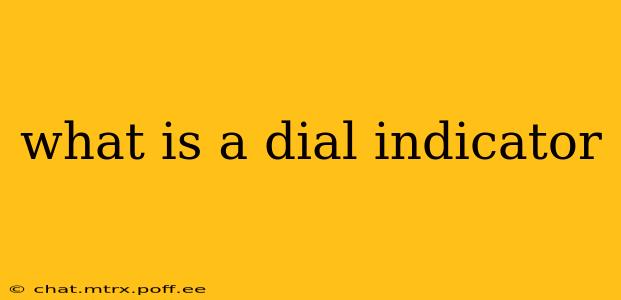A dial indicator, also known as a dial gauge or test indicator, is a precision measuring instrument used to measure small displacements or variations in dimension. It's a versatile tool found in various industries, from machining and manufacturing to automotive repair and quality control. Unlike other measuring tools that provide a single measurement, a dial indicator offers continuous readings, allowing for dynamic measurements and precise detection of minute changes in surface position or alignment.
How Does a Dial Indicator Work?
At its heart, a dial indicator is a mechanical device consisting of a contact point (probe), a rack and pinion mechanism, and a dial face displaying the measurement. When the contact point is moved, the rack and pinion system translates the linear movement into rotational movement, which is amplified and shown on the dial face. This amplification allows for the measurement of extremely small distances, often down to thousandths of an inch or millimeters.
The dial face itself is typically graduated in increments of 0.001 inches or 0.01 millimeters, allowing for highly precise measurements. Many models offer features like a bezel for zeroing the indicator and different measurement ranges depending on the application.
What are the Different Types of Dial Indicators?
Several types of dial indicators cater to different needs and applications:
-
Standard Dial Indicators: These are the most common type, offering a simple and reliable way to measure linear displacement. They are widely available and relatively inexpensive.
-
Lever Dial Indicators: These indicators use a lever arm to amplify the movement, allowing for measurements in tighter spaces or on surfaces that are difficult to access with a standard indicator.
-
Magnetic Dial Indicators: These have a magnetic base, allowing for easy attachment to ferrous metal surfaces. This eliminates the need for clamps or other holding mechanisms.
-
Digital Dial Indicators: These offer a digital display instead of an analog dial, providing easier readability and often the ability to record and store measurements.
-
Test Indicators: These are often smaller and more compact than standard dial indicators, designed for quick checks and alignment verification.
What are Dial Indicators Used For?
Dial indicators are indispensable tools in numerous applications:
-
Measuring surface flatness and straightness: Detecting even minor deviations from flatness or straightness on machined parts or surfaces.
-
Checking alignment and parallelism: Ensuring components are properly aligned or parallel to each other. This is crucial in many manufacturing processes.
-
Measuring runout: Assessing the concentricity of rotating parts, such as shafts or bearings. Runout is a critical factor in machine performance and safety.
-
Checking the accuracy of machine tools: Verifying the precision of lathes, milling machines, and other equipment.
-
Automotive repair and maintenance: Checking engine component alignment, wheel alignment, and other essential adjustments.
What is the Accuracy of a Dial Indicator?
The accuracy of a dial indicator depends on its quality and grade. High-quality indicators offer greater accuracy and repeatability. It's crucial to select an indicator appropriate for the required level of precision. Always consult the manufacturer's specifications to understand the accuracy limits of a specific model.
How Do I Read a Dial Indicator?
Reading a dial indicator is straightforward. The main dial shows the primary measurement, typically in inches or millimeters. The smaller inner dial often provides additional precision, showing fractions of the main dial's increments. Always ensure you understand the units and increments of your specific indicator.
How to Use a Dial Indicator?
Proper use is essential to obtain accurate measurements. This generally involves securing the indicator to a stable base, properly positioning the contact point, and carefully moving the contact point across the surface being measured. Refer to the manufacturer's instructions for detailed guidance on proper usage.
This comprehensive guide provides a solid understanding of dial indicators, their types, applications, and usage. Remember to always handle these precision instruments with care to ensure accurate and reliable measurements.
